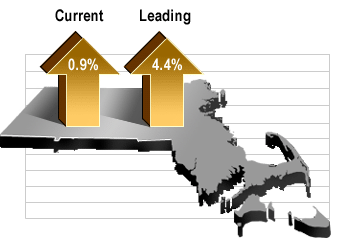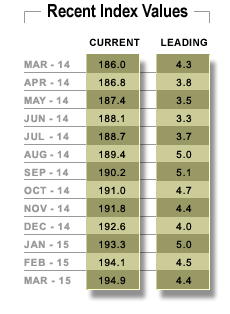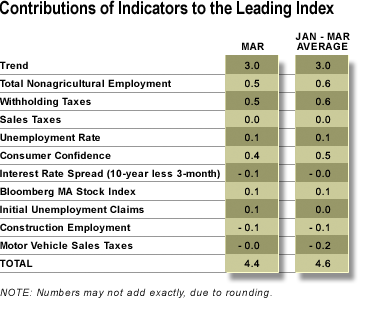Massachusetts economy weathers the storm in Q1 2015, UMass journal reports
State growth slows significantly but economic expansion continues despite record snowfall.
March 2015
 Massachusetts real gross domestic product grew at an estimated annual rate of 0.9 percent in the first quarter of 2015 according to the MassBenchmarks Current Economic Index, released today by MassBenchmarks, the journal of the Massachusetts economy published by the UMass Donahue Institute in collaboration with the Federal Reserve Bank of Boston. U.S. real domestic gross product grew at an annual rate of 0.2 percent according to the advance estimate of the U.S. Bureau of Economic Analysis.
Massachusetts real gross domestic product grew at an estimated annual rate of 0.9 percent in the first quarter of 2015 according to the MassBenchmarks Current Economic Index, released today by MassBenchmarks, the journal of the Massachusetts economy published by the UMass Donahue Institute in collaboration with the Federal Reserve Bank of Boston. U.S. real domestic gross product grew at an annual rate of 0.2 percent according to the advance estimate of the U.S. Bureau of Economic Analysis.
Based on the latest available information, we now estimate that in the fourth quarter of 2014, the state economy expanded at a 2.9 percent annualized rate while the nation grew at a more modest 2.2 percent rate. This represents a downward revision in Massachusetts growth of 1.8 percentage points from the original fourth quarter estimate of 4.7 percent. This adjustment is due to a decline of 0.8 percentage points in estimated productivity growth and a decline of 1.0 percentage points that is largely the result of downward revisions to state job growth in November and December.
Record snowfall and weak global economic conditions dampened growth in the first quarter, but the state economy has proven to be resilient in spite of these dual headwinds. In the first quarter, Massachusetts payroll employment expanded at a 1.6 percent annual rate, down from a 2.0 percent rate in the fourth quarter of 2014. Nationally, payroll employment grew at a 2.2 percent annual rate in the first quarter. The state’s unemployment rate declined by half a percentage point in the first quarter, from 5.3 percent in December to 4.8 percent in March. During the same period, the U.S. unemployment rate fell from 5.6 percent to 5.5 percent.
 "While the economic tide continued to rise in the first quarter, it is still not lifting all boats," noted Alan Clayton-Matthews, MassBenchmarks Senior Contributing Editor and Associate Professor of Economics and Public Policy at Northeastern University, who compiles and analyzes the Current and Leading Indexes. The broader U-6 measure of unemployment — which includes part-time workers who want full-time work and those who are unemployed but marginally attached to the labor force — also fell in the first quarter. "In March, Current Population Survey-based estimates put the Massachusetts U-6 rate at 10.1 percent. The corresponding U.S. rate in March was 10.9 percent," Clayton-Matthews added.
"While the economic tide continued to rise in the first quarter, it is still not lifting all boats," noted Alan Clayton-Matthews, MassBenchmarks Senior Contributing Editor and Associate Professor of Economics and Public Policy at Northeastern University, who compiles and analyzes the Current and Leading Indexes. The broader U-6 measure of unemployment — which includes part-time workers who want full-time work and those who are unemployed but marginally attached to the labor force — also fell in the first quarter. "In March, Current Population Survey-based estimates put the Massachusetts U-6 rate at 10.1 percent. The corresponding U.S. rate in March was 10.9 percent," Clayton-Matthews added.
Despite the severe winter weather, Massachusetts income and spending continued to grow in the first quarter of 2015. State withholding tax receipts indicate that wage and salary income in Massachusetts expanded at a 4.8 percent annualized rate in the first quarter. This was down from a robust 10.7 percent annualized rate in the fourth quarter of 2014. The impact of February's record snowfall can be seen in state sales tax collections, which declined sharply for both automobiles and other items subject to the regular sales tax. Nevertheless, spending on these taxable items continued to expand in the first quarter, growing at a 1.8 percent annualized rate in the first quarter, down from a 7.4 percent rate in the previous quarter.
The economic problems in Europe, the slowdown in growth in China, and the strong U.S. dollar are headwinds for both the national and state economies. In 2014, merchandise exports grew only 2.8 percent for Massachusetts and 2.0 percent for the U.S. In the first two months of 2015, merchandise exports were down 4.6 percent for Massachusetts and 12.8 percent for the U.S. as compared to the first two months of 2014. Some of the reasons for these declines may prove temporary including the severe winter weather in the Northeast and port closings on the west coast. However, export growth may remain weak all year as a result of the strong dollar and the relatively weak prospects for international growth.
 The 10 indicators that comprise the leading index usually do not all move in tandem. Typically, some may indicate an expectation of faster than average growth, while at the same time others may indicate an expectation of slower than average growth. The table accounts for the contributions of each towards faster or slower growth than the trend of 3.0 percent. The index value is their sum.
The 10 indicators that comprise the leading index usually do not all move in tandem. Typically, some may indicate an expectation of faster than average growth, while at the same time others may indicate an expectation of slower than average growth. The table accounts for the contributions of each towards faster or slower growth than the trend of 3.0 percent. The index value is their sum.
In March, six indicators contributed to a forecast of above-trend growth: total nonagricultural employment, withholding taxes, the unemployment rate, consumer confidence, the Bloomberg stock index for Massachusetts, and initial unemployment claims. Two indicators contributed to average-trend growth: sales taxes, and motor vehicle sales taxes. Two indicators contributed to below-trend growth: the interest rate spread between 10-year and 3-month U.S. Treasury securities, and construction employment.
In the three-month period January through March, five indicators contributed to a forecast of above-trend growth: total nonagricultural employment, withholding taxes, the unemployment rate, consumer confidence, and the Bloomberg stock index for Massachusetts. Three indicators contributed to average-trend growth: sales taxes, the interest rate spread between 10-year and 3-month U.S. Treasury securities, and initial unemployment claims. Two indicators contributed to below-trend growth: construction employment, and motor vehicle sales taxes.
The current and historical quarterly estimates for state domestic product growth include adjustments for changes in productivity growth. These adjustments are estimates of the quarterly deviations from trend in the growth of the ratio of output to employment and output to wage and salary income. In the first quarter of 2015, these adjustments subtracted 3.9 percentage points from the annual rate of growth. In the fourth quarter of 2014, these adjustments subtracted 2.2 percentage points from the annual rate of growth. For the forecast of state domestic product growth in the second and third quarters of this year, productivity growth is assumed to return to its trend.
Several recent months of the indices are revised each release. These revisions are a result of the statistical method used to create the index, as well as revisions in the underlying indicators.
--------
All of the indicators except interest rates refer to Massachusetts. The current index is composed of four indicators: nonagricultural employment, withholding taxes, sales taxes, and the unemployment rate. The leading index includes these four current indicators plus the other six (leading) indicators in the contributions table. All of the indicators are as of March, except for interest rates and the Bloomberg stock index for Massachusetts, which are through April 23. The MassInsight Consumer Confidence Index is released every third month. Intervening months are interpolated, and changes in the Conference Board's Consumer Confidence Index for the U.S. are used to extrapolate to the current month of the index, as needed. Series measured in current dollars or values, i.e., withholding taxes, sales taxes, the Bloomberg stock index, and motor vehicle sales taxes, are deflated by the U.S. consumer price index for all urban consumers, excluding food and energy.
For a description of the methodology used to construct these indices, see: Alan Clayton-Matthews and James H. Stock, "An application of the Stock/Watson index methodology to the Massachusetts economy," Journal of Economic and Social Measurement, vol. 25 (1998/1999), pp. 183-233.
Dr. Alan Clayton-Matthews
MassBenchmarks
Northeastern University, School of Public Policy and Urban Affairs
April 29, 2015

